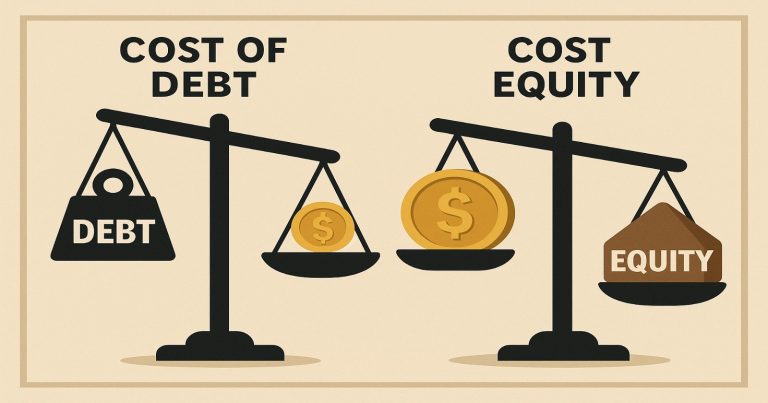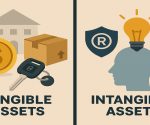The cost of debt and the cost of equity differ in terms of nature, calculation, and effect on capital structure. Cost of debt is defined as the amount of expense incurred while borrowing funds, such as interest on loans or bonds. Cost of equity refers to the return that shareholders are expected to obtain by buying shares to provide capital. Both measures are important in the analysis of a company’s weighted average cost of capital (WACC) and financial decisions.
What is Cost of Equity?
Cost of equity refers to the amount that a company needs to provide to its shareholders to compensate for the risk involved with investing in the company. In other words, it is a rate of return that equity investors expect from their invested money. Unlike in debt investment, there is no fixed payment, but equity is often costlier because of the higher risk in a stock investment.
Key Features of Cost of Equity
The cost of equity represents the return that shareholders expect for investing in a company’s shares, compensating for the risks they undertake. Here’s an overview of its key features:
- Risk-Based Return: Shareholders expect higher returns due to the inherent risk of investing in shares or stocks, which have no fixed payout.
- No Fixed Payments: There is no fixed payment, like regular payments for equity capital, except by the company. Returns are provided through dividends and capital appreciation.
- Performance-Based: The equity cost is affected by the market, profitability, and prospects of growth in a company.
- Calculation Complexity: The cost of equity is often determined using complex financial models like the Capital Asset Pricing Model (CAPM).
How to Calculate Cost of Equity
One of the most commonly used methods is the Capital Asset Pricing Model (CAPM):
Cost of Equity (Ke)=Rf+β(Rm−Rf)
Where:
- Rf: Risk-free rate (e.g., returns on government bonds)
- β (Beta): Measure of a stock’s volatility compared to the market
- Rm: Expected return of the market
Importance of Cost of Equity
The cost of equity plays a critical role in financial decision-making, serving as a benchmark for evaluating investment viability and company performance. It provides insights into shareholder expectations and is essential for accurate company valuation and strategic planning.
- Investment Decisions: Helps determine whether projects or investments will meet shareholders’ return expectations.
- Company Valuation: The cost of equity is a key input in valuation models like Discounted Cash Flow (DCF).
- Performance Evaluation: Assesses the effectiveness of management in delivering shareholder returns.
What is Cost of Debt?
The cost of debt is the effective rate a company pays on its borrowed funds, such as loans, bonds, Debentures, or other debt instruments. It reflects the interest payments made to creditors and is usually tax-deductible, reducing the overall expense for the company.
Key Features of Cost of Debt
The cost of debt represents the effective expense a company incurs to borrow funds, typically through loans or bonds. Here are its key features.
- Fixed Obligation: The company can easily predict the specific interest that is paid out on this debt.
- Lower Cost than Equity: Since it entails lower risk (secured by assets or repayment priority), debt is, in general, less expensive as opposed to equity.
- Tax deductibility: The interest paid on debt is tax-deductible, which lowers the effective cost for companies.
- Maturity Period: Debt instruments usually have a fixed time after which the principal has to be repaid.
How to Calculate Cost of Debt
The cost of debt is calculated to determine the effective interest expense a company incurs on its borrowings, adjusted for tax benefits. The after-tax cost of debt is computed using the following formula:
Cost of Debt (Kd)=Total Interest/Total Debt×(1−Tax Rate)
Importance of Cost of Debt
The cost of debt is crucial for understanding the financial implications of borrowing, helping companies make informed decisions about their capital structure, tax benefits, and cash flow management. Here’s why it is important.
- Tax Savings: It is because interest is tax-deductible, debt becomes an appealing source of financing.
- Capital Structure Decisions: Helps companies decide the optimal mix of debt and equity for funding.
- Cash Flow Management: It gives a clear understanding of fixed obligations and their effect on Cash Flow or corporate finances.
Key Differences Between Cost of Debt & Cost of Equity
Understanding the key differences between the cost of debt and cost of equity is essential for optimizing a company’s Financial statements and financing strategy. These differences highlight the unique roles each plays in funding and financial management.
Nature of the Cost
- Cost of Debt: It is concerned with the explicit cost of borrowing, which explicitly involves interest.
- Cost of Equity: It is the implicit cost of compensating shareholders for their investment risk. Cost of equity.
Tax Treatment
- Cost of Debt: Interest payments are tax-deductible, reducing the effective cost of debt.
- Cost of Equity: Dividends paid to shareholders are not tax-deductible, making equity more expensive.
Risk Level
- Cost of Debt: Since debt takes precedence over equity in case of bankruptcy and since the repayment is fixed, it is less risky.
- Cost of Equity: Equity is riskier because shareholders are paid last in case of liquidation, and returns depend on the performance of the market.
Payment Obligation
- Cost of Debt: Payments are mandatory, and missing them can lead to penalties or bankruptcy.
- Cost of Equity: Payments to shareholders, like dividends, are discretionary and depend on company performance.
Calculation Method
- Cost of Debt: Simple to calculate using interest rates and debt amounts, adjusted for taxes.
- Cost of Equity: Complex to calculate, often requiring financial models like CAPM or dividend discount models.
Impact on Financial Leverage
- Cost of Debt: Increases financial leverage, which may increase returns by increasing financial risk.
- Cost of Equity: There is no financial leverage added but needs to be managed sensitively to investor expectations.
| Aspect | Cost of Debt | Cost of Equity |
| Nature of Cost | Explicit cost: Interest payments | Implicit cost: Shareholder compensation |
| Tax Treatment | The tax-deductible interest reduces the effective cost | Dividends are not tax-deductible |
| Risk Level | Less risky: Fixed repayment, priority in claims | Riskier: Paid after debt, depends on the market |
| Payment Obligation | Mandatory, with penalties for defaults | Discretionary, based on company performance |
| Formula | Cost of Debt (Kd)=Total Interest/Total Debt×(1−Tax Rate) | Cost of Equity (Ke)=Rf+β(Rm−Rf) |
| Calculation Method | Simple: Interest rates adjusted for taxes | Complex: Requires CAPM or dividend models |
| Impact on Leverage | Increases financial leverage and risk | No leverage, but affects shareholder trust |
Conclusion
The difference between cost of debt and cost of equity is primarily seen in their role in the financial structure of a company. Debt may have an advantage over equity because it reduces income taxes, since those become set obligations. Equity represents a more flexible but costlier source of finance. Together, they form the foundation of a company’s weighted average cost of capital (WACC) that helps determine financing and investment decisions. Companies must keep these costs balanced to be stable financially and to maximize shareholder value.
Cost of Debt vs Cost of Equity FAQs
What is cost of debt?
The cost of debt is the effective rate a company pays on its borrowed funds, including loans and bonds, adjusted for tax savings.
What is cost of equity?
The cost of equity is the return investors expect for the risk of investing in a company’s shares.
Why is cost of debt less than the cost of equity?
Debt is less risky to the lender, and the repayments are specific with priority at the time of liquidation, while the interest is tax-deductible.
How is the cost of equity calculated?
The capital cost of equity mainly uses the Capital Asset Pricing Model (CAPM) with risk-free rates, beta, and market returns.
How do businesses decide whether to use debt versus equity financing?
Companies take into consideration the cost, risk, tax benefits, and financial flexibility in determining the optimal mix of debt and equity.


